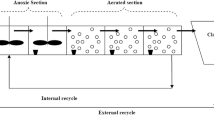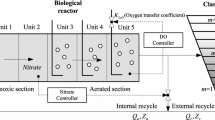Abstract
This paper involves the use of state-of-the-art optimization techniques to conduct the wastewater treatment process in the most beneficial manner possible. Rigorous single- and multi-objective optimal control tasks are performed on the reduced BSM1 (benchmark simulation model 1) for the wastewater treatment process problem. The multiobjective optimization does not involve weight functions or additional constraints. The state-of-the-art global optimization solver BARON is used. The concentrations of the Nitrite/Nitrate, ammonium and biodegradeable organic contaminants are minimized. While the single and multiobjective optimal control profiles for the Nitrite/Nitrate and the biodegradable substance concentrations were qualitatively similar, there was considerable difference between the two profiles when the ammonium concentration profile was minimized. However, when the time for the multiobjective optimal control was increased, resulting profiles for the ammonium concentrations became similar. This demonstrated that increasing the time enabled the multiobjective optimal control to be as effective as the single objective optimal control while controlling all the variables.





Similar content being viewed by others
References
Adhikari S, Halden RU (2022) Opportunities and limits of wastewater-based epidemiology for tracking global health and attainment of UN sustainable development goals. Environ Int 163:107217. https://doi.org/10.1016/j.envint.2022.107217
Amand L, Olsson G, Carlsson B (2013) Aeration Control—a review. Water Sci Technol 67:2374–2397
Andreottola G, Foladori P, Ragazzi M (2001) On-line control of a SBR system for nitrogen removal from industrial wastewater. Water Sci Technol 43(3):93–100
Barceló D (2020) Wastewater-Based Epidemiology to monitor COVID-19 outbreak: present and future diagnostic methods to be in your radar Case Stud. Chem Environ Eng 2:100042. https://doi.org/10.1016/j.cscee.2020.100042
Barrou O, Karama A, Lakhal EK, Bernard O, Pons M-N, Corriou J-P (2008) Estimation of a Reduced Model of the BSM1 Activated Sludge Wastewater Treatment Plant, Vol 6, Article A63, (2008)
Biegler LT (2007) An overview of simultaneous strategies for dynamic optimization. Chem Eng Process.: Process Intensif 46:1043–1105
Bijlsma L, Bade R, Been F, Celma A, Castiglioni S (2021) Perspectives and challenges associated with the determination of new psychoactive substances in urine and wastewater—a tutorial Anal. Chim Acta 1145:132–147. https://doi.org/10.1016/j.aca.2020.08.058
Brdys MA, Grochowski M, Gminski T, Konarczak K, Drewa M (2008) Hierarchical predictive control of integrated wastewater treatment systems. Control Eng Pract 16:751–767
Bussieck MR, Meeraus A (2004) General Algebraic Modeling System (GAMS). In Kallrath J. (eds). Modeling Languages in Mathematical Optimization. Applied Optimization, vol 88. Springer, Boston, MA
Chen J, Venkatesan AK, Halden RU (2019) Alcohol and nicotine consumption trends in three U.S. communities determined by wastewater-based epidemiology. Sci Total Environ pp. 174–183. doi:https://doi.org/10.1016/j.scitotenv.2018.11.350.656
Darby ML, Nikolau M, Jones J, Nicholson D (2011) RTO: An overview and assessment of current practice. J Process Control 21:874–884
Daughton CG (2018) Monitoring wastewater for assessing community health: Sewage Chemical-Information Mining (SCIM). Sci Total Environ 619–620:748–764. https://doi.org/10.1016/j.scitotenv.2017.11.102
Daverey A, Pandey D, Verma P, Verma S, Shah V, Dutta K, Arunachalam K (2019) Recent advances in energy efficient biological treatment of municipal wastewater. Bioresour Technol Rep 7:100252
Dionisi D (2017) Biological Wastewater Treatment Processes, 1st edn. CRC Press, Boca Raton, FL, US
Dionisi D, Rasheed AA, Majumder A (2016) A new method to calculate the periodic steady state of sequencing batch reactors for biological wastewater treatment: model development and applications. J Environ Chem Eng 4(3):3665–3680
Flores-Tlacuahuac A, Morales P, Riveral Toledo M (2012) Multiobjective Nonlinear model predictive control of a class of chemical reactors. I & EC Res 51:5891–5899
Gómez-Quintero C-S, Spérandio IQM (2004) A reduced linear model of an activated sludge process. IFAC Proc 37(3):219–224
Hart WE, Laird CD, Watson J-P, Woodruff DL, Hackebeil GA, Nicholson BL, Siirola JD (2017) Pyomo – Optimization Modeling in Python. Second Edition. Vol. 67. Springer
Henze M, Van Loosdrecht MCM, Ekama GA, Brdjanovic D (2008) Biological Wastewater Treatment: Principles. Iwa publishing, London, Modelling and Design
Hulsbeek JJW, Kruit J, Roeleveld PJ, van Loosdrecht MCM (2002) A practical protocol for dynamic modelling of activated sludge systems. Water Sci Technol 45(6):127–136
Julien S, Lessard P, Babary JP (1999) A reduced-order model for control of a single reactor activated sludge process. Math Comp Mod Dyn Syst 5(3):337–350
Martin AD (2000) Interpretation of residence time distribution data. Chem Eng Sci 55:5907–5917
McCarty PL, Bae J, Kim J (2011) (2011) Domestic wastewater treatment as a net en- ergy producer–can this be achieved? Environ Sci Technol 45:7100–7106
Meijer SCF, van Loosdrecht MCM, Heijnen JJ (2001) Metabolic modelling of full scale biological nitrogen and phosphorus removing wwtp. Water Res 35:2711–2723
Miettinen, KM (1999) Nonlinear Multiobjective Optimization; Kluwers international series
O’Brien M, Mack J, Lennox B, Lovett D, Wall A (2011) Model predictive control of an activated sludge process: a case study. Control Eng Pract 19:54–61
Olsson G, Nielsen M, Yuan Z, Lynggaard-Jensen A, Steyer J-P (2005) Instrumentation, Control and Automation in Wastewater Systems. IWA Publishing, London, UK
Papadimitriou CA, Samaras P, Sakellaropoulos GP (2009) Comparative study of phenol and cyanide containing wastewater in CSTR and SBR activated sludge reactors. Bioresour Technol 100(1):31–37
Piotrowski R, Brdys MA, Konarczak K, Duzinkiewicz K, Chotkowski W (2008) Hierarchical dissolved oxygen control for activated sludge processes. Control Eng Pract 16:114–131
Santín I, Pedret C, Vilanova R (2015a) Applying variable dissolved oxygen set point in a two level hierarchical control structure to a wastewater treatment process. J Process Control 28:40–55
Santín I, Pedret C, Vilanova R (2015b) Fuzzy control and model predictive control configurations for effluent violations removal in wastewater treatment plants. Ind Eng Chem Res 54:2763–2775
Santin I, Pedret C, Vilanova R (2016) Control and Decision Strategies in Wastewater Treatment Plants for Operation Improvement. Springer, Cham, Switzerland
Silvana R, Vega P, Vilanova R, Francisco M (2017) Optimal control of wastewater treatment plants using economic-oriented model predictive dynamic strategies. Appl Sci 7:813
Singh KS, Viraraghavan T (2002) Modelling of sludge blanket height and flow pattern in UASB reactors treating municipal Wastewater. Wastewater Treatment 1:1–8
Sridhar LN (2019) Multiobjective optimization and nonlinear model predictive control of the continuous fermentation process involving Saccharomyces Cerevisiae. Biofuels. https://doi.org/10.1080/17597269.2019.1674000 (ISSN:1759-7269(Print)1759-7277)
Steffens MA, Lant PA, Newell RB (1997) A Systematic Approach for Reducing Complex Biological Wastewater Treatment Models. Wat Res 31(3):590–606
Tatjewski P (2008) Advanced control and on-line process optimization in multilayer structures. Ann Rev Control 32:71–85
Tawarmalani M, Sahinidis NV (2005) A polyhedral branch-and-cut approach to global optimization. Math Program 103(2):225–249
Vega P, Revollar S, Francisco M, Martin JM (2014) Integration of set point optimization techniques into nonlinear MPC for improving the operation of WWTPs. Comput Chem Eng 68:78–95
Yalmaz G, Öztürk I (2001) Biological ammonia removal from anaerobically pre-treated landfill leachate in sequencing batch reactors (SBR). Water Sci Tech- Nol 43(3):307–314
Zeng J, Liu J (2015) Economic model predictive control of wastewater treatment processes. Ind Eng Chem Res 54:5710–5721
Zhao H, Isaacs SH, Soeberg H, Kümmel M (1994) A Novel control strategy for improved nitrogen removal in an alternating activated sludge process - part i wat. Res 28(3):521–534
Funding
There is no funding to report.
Author information
Authors and Affiliations
Corresponding author
Ethics declarations
Conflict of interest
There is no conflict of interest. All the codes of ethical conduct have been adhered to.
Additional information
Publisher's Note
Springer Nature remains neutral with regard to jurisdictional claims in published maps and institutional affiliations.
Rights and permissions
Springer Nature or its licensor holds exclusive rights to this article under a publishing agreement with the author(s) or other rightsholder(s); author self-archiving of the accepted manuscript version of this article is solely governed by the terms of such publishing agreement and applicable law.
About this article
Cite this article
Sridhar, L.N. Single and Multiobjective Optimal Control of the Wastewater Treatment Process. Trans Indian Natl. Acad. Eng. 7, 1339–1346 (2022). https://doi.org/10.1007/s41403-022-00368-6
Received:
Accepted:
Published:
Issue Date:
DOI: https://doi.org/10.1007/s41403-022-00368-6




